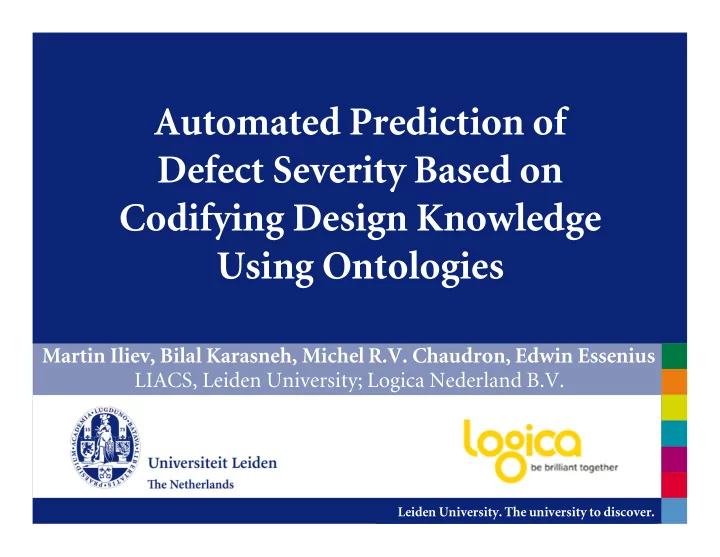

Automated Prediction of Defect Severity Based on Codifying Design Knowledge Using Ontologies Martin Iliev, Bilal Karasneh, Michel R.V. Chaudron, Edwin Essenius LIACS, Leiden University; Logica Nederland B.V. Leiden University. The university to discover.
Overview - Introduction - Background information • Ontologies • Case study - Case study approach • Data collection • Data analysis and conversion • Data classification - Results - Current research - Conclusion 2 Leiden University. The university to discover.
Introduction - Software testing and software defects. - What is defect severity? - Who assigns severity levels to defects and how? 3 Leiden University. The university to discover.
Background Information - Ontologies – explicit formal specifications of the terms in a domain and the relations among them. - Industrial case study • Conducted at Logica, the Netherlands. • Logica has developed the front-end software for an embedded traffic control system. 4 Leiden University. The university to discover.
Step 1 Step 2 Step 3 Data Collection - The data represent defect reports from the testing phase of the project. - 33 out of 439 defects were selected in a representative sample from the defect tracking system. Number of Fixed Defects Severity Level In all versions of the In the latest version of Selected for the system the system case study Minor 85 12 5 Medium 301 93 17 Severe 47 10 10 Showstopper 6 1 1 Total 439 116 33 5 Leiden University. The university to discover.
Step 1 Step 2 Step 3 Data Analysis - The selected defect reports contain project- specific information. - Convert the project-specific information into project-independent defect attributes and their values as defined in the IEEE standard. - Used attributes from the standard: • severity, effect, type, insertion activity, detection activity. 6 Leiden University. The university to discover.
Step 1 Step 2 Step 3 Data Conversion Example of the information in the defect reports Defect Reasons for Found Severity Description Causes Type ID Severity during? The buttons for directions I/O Value Wrong data is System 342 Medium are reversed. When the exception… defect… displayed… testing left button is pressed… ... Examples after the conversion of the defects’ information Attributes Defect Insertion Detection ID Severity Effect Type Activity Activity Functionality; security; Data; Supplier 101 Blocking Design performance; serviceability interface testing Supplier 102 Critical Usability; performance Logic Coding testing ... 7 Leiden University. The university to discover.
Step 1 Step 2 Step 3 Data Classification - Develop the ontology and input the converted information about the defects in it. - Define the reasoning rules for classifying the defects into the categories • Major severity level – Rule 1 • Medium severity level – Rule 2 • Minor severity level – Rule 3 8 Leiden University. The university to discover.
Step 1 Step 2 Step 3 Rule 1: …(R1.2) (isInserted only (InDesign or InRequirements)) or ((isInserted only (InCoding or InConfiguration)) and (hasEffectOnNumber min 3)) or … (R1.3) hasEffectOnNumber min 2 (R1.4) hasType only (Data or Interface or Logic) (R1.5) isDetected only (FromSupplierTesting or FromCoding) 9 Leiden University. The university to discover.
Case Study Results Attributes Defect ID Effect Type Insertion Activity Detection Activity Functionality; security; 101 Data; interface Design Supplier testing performance; serviceability 102 Usability; performance Logic Coding Supplier testing 103 Functionality; performance Logic Design Supplier testing … input in developed for Classification rules outputs Defect ID Predicted Severity Level 101 Major 102 Medium 103 Major … … 10 Leiden University. The university to discover.
Comparison of the Results Automatic (Ontology) Classification MajorSL MediumSL MinorSL MajorSL 3 0 8 Manual MediumSL 7 4 (Original) 6 Classification MinorSL 0 0 5 - Out of all defects: • 58% – classified in the same SLs by both classifications. • 42% – classified differently (21% higher, 21% lower). - Reasons for the differences. 11 Leiden University. The university to discover.
Current Research - Achieved more promising results: • 2 nd case study showed better results. - In the process of: • validating the results and testing the genericity of the classification rules. • comparing the ontology classification results with the results obtained by an existing machine learning workbench – the Weka workbench. 12 Leiden University. The university to discover.
Conclusion - The presented method: • automates the process of assigning severity levels to defects. • could be useful for large software systems with many defects. • could aid in the testing phase by decreasing the workload of the test analysts. 13 Leiden University. The university to discover.
Recommend
More recommend